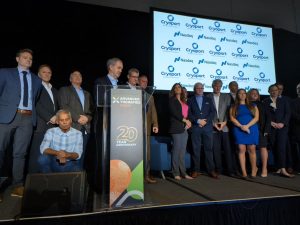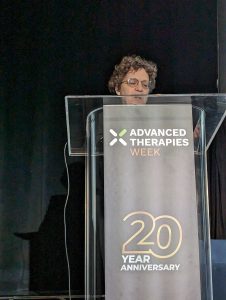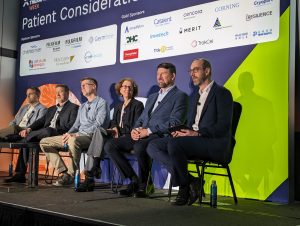If you have finally recovered from Advanced Therapies Week (ATW) 2024, don’t get too comfortable since the website for ATW 2025, to be held in San Diego, California, is already published. It’s worth visiting as it features some nice photos of this year’s event to remind us of the parties, the important plenary conversations and the sunshine. (I covered some highlights of the conference last week in Positive outlook on industry lends party atmosphere to ATW2024.)
But there is so much more to share! For example, during the opening plenary on January 17, a special broadcast was arranged. Robert Stefanovich, Chief Financial Officer at Cryoport Systems, rang the bell at Nasdaq in New York City to signal the opening of the market and unveil the company’s new branding. We watched it happen live from Miami with the large Cryoport team, including Jerrell W. Shelton, President and CEO, who were on stage clapping and cheering, and visible to the group at Nasdaq. (Robert Stefanovich begins speaking at 4:00.)
Celia Witten, Deputy Director, CBER, FDA, presented regulatory updates for cell and gene therapy. First she reminded us of all the approved gene therapies in the U.S. – 17 since 2017, with five happening in 2023 – and four U.S. approved cell therapies between 2021 and 2023: Lantidra, Omisurge, Rethymic and Stratagraft.
She spoke about the advantages of allogeneic CAR T cells, reasons why CAR T cells for solid tumours are still moving slowly, and numerous safety concerns. She also announced several pilot programs (read my previous blog, above) and seemed enthusiastic about new efforts that are promoting engagement with patients and caregivers.
The opening plenary, chaired by Chad Salisbury, Senior Vice President, Project Farma, ended with a question for the panelists: What is everyone most excited about?
Dr. Witten answered that she is pleased to see advances in gene therapy development and encouraged to see more patient engagement, plus that it is happening at an earlier stage. Lore Gruenbaum, Vice President, Therapy Acceleration Program with The Leukemia & Lymphoma Society, said she’d like to see CAR T-cell therapy move into first line treatment and allogeneic therapy continue to make progress. Warner Biddle, Global Head of Commercial, Kite, a Gilead Company, joined us virtually. He was excited with improvements in patient outcomes and new data, along with advanced therapies for multiple myeloma. As he put it, there’s “lots of shots on goal to improve outcomes for patients.”
Weathering A Biotech Storm – Global Pressures on Cell and Gene Therapies and How to Secure Your Biotech’s CGT Future
Warner Biddle was back later in the day for a session chaired by Arthur Stril, Chief Business Officer, Cellectis. On the theme “Weathering A Biotech Storm – Global Pressures on Cell and Gene Therapies and How to Secure Your Biotech’s CGT Future” Biddle talked about how time and consistency are crucial for positive patient outcomes, hence their investments in geographic expansion into 26 countries. Kite wants clinics to be close to patients and they currently have 390 authorized treatment centres around the globe where patients can receive CAR T-cell therapy.
He pointed out that, currently, only two of 10 U.S. patients get access to CAR T. (In another session we heard that less than three per cent globally can access these therapies.) Biddle believes improving access to referrals, and more awareness and education, for both patients and clinicians, will move the needle. Another message from Biddle, and one that manufacturers can get behind, is to “build manufacturing into your treatment plan.”
Raphael Ognar, President & CEO, Co-Founder NKILT Therapeutics Inc., made the point that access is not just pricing, it is bringing therapies to more patients. He recommended early dialogue with the FDA to improve education.
Beyond the U.S., this study titled “Gene therapy access: Global challenges, opportunities, and views from Brazil, South Africa, and India” by Kenneth Cornetta et al, states “Cost is not the only challenge for improving access. Many [low- and middle-income countries] LMICs lack the population health infrastructure available in [high income countries]. For example, newborn screening is not available in many LMICs. Similarly, cancer screening is not part of many health systems. Electronic medical record systems are just being developed, and laboratory diagnostics are often limited. Standard-of-care treatment, if available, is usually concentrated in urban areas. Individuals’ preferences for herbal medications and spiritual healing, lack of medical literacy at the individual and local healthcare provider level, and fear of the diagnosis are also factors that delay diagnosis and treatment. Failure to allow the process to be developed locally may limit attempts to bring a new technology forward.” There are lots of barriers still to be overcome!
The Cost Conundrum – How Do We Reduce the Price to Patients?
Although access is not just pricing, the industry still needs to reduce costs. Tom Whitehead, Founder of the Emily Whitehead Foundation (and Emily’s father), was speaking on a panel titled “The Cost Conundrum – How Do We Reduce the Price to Patients?” and he said that he knows patients who won’t join a clinical trial for fear it will leave the family in debt due to hospital costs. He talked about medical debt collection and going into bankruptcy for care, and the additional burden patients have when trials are in different states or different countries.
So there is the cost of therapies, but there is also the high price of medical care. One important point that came up during the panel was to remember that a patient’s endpoint may differ from the clinician’s, the biotech company’s and the regulator’s. That may lower the cost in some cases.
Timothy Nelson, Co-Founder & CEO of HeartWorks, “the world’s largest team dedicated to curing” congenital heart defects (CHD), stated that hospitals make a lot of money treating and caring for patients, but his group’s hospital consortium has saved US$5-6 million in clinical trials by absorbing some “trivial” costs that don’t hurt their operations. HeartWorks is a non-profit foundation that has designed a unique platform to bring together physicians, scientists and engineers to treat CHD while advancing research in stem cell biology, genetics, cell manufacturing and clinical trials. Learn more about HeartWorks.
There are many remarkable people who give presentations at ATW and Allyson Berent is one of them. A veterinary specialist, Dr. Berent is the Chief Science Officer of the Foundation for Angelman Syndrome Therapeutics (FAST), the Chief Operating Officer of GeneTx Biotherapeutics, a company targeting the development of an antisense oligonucleotide for the treatment of Angelman syndrome, and the Chief Development Officer for Mahzi Therapeutics, a biotech developing therapies for patients with rare genetic diseases. She is also the mother of three daughters, one of whom lives with Angelman syndrome. Her talk at ATW was moving and inspiring. (Actually, I saw her speak twice during the program.)
The video below is not as current as some featuring Dr. Berent, but it’s a short introduction to what she is passionate about. For something more current, I suggest you watch this (longer) video from November 2023 on FAST’s progress to date.
Stacey Johnson
Latest posts by Stacey Johnson (see all)
- Right Turn: Can Bryan Johnson live forever? Will regenerative medicine help him do so? - October 10, 2025
- Right Turn: #pinksocks, diabetes news and other ramblings - June 24, 2025
- Right Turn: Some takeaways from Advanced Therapies Week 2025 - January 31, 2025









Comments